InOsteoD: A Cost-effective Integrative Approach for Osteoporosis Detection
DOI:
https://doi.org/10.63635/mrj.v1i1.5Keywords:
Osteoporosis, X-ray Deep learning, features;, classificationAbstract
Osteoporosis is a prevalent bone condition that typically affects older adults, occurring when bone mineral density and bone mass decline or when the bone’s quality or structure deteriorates. It increases the risk of bone fractures and causes many complications for patients. X-ray is a low-cost medical imaging test that can be used for predicting Osteoporosis by extracting relevant and non-redundant features followed by appropriate downstream analysis. This paper presents a cost-effective integrative approach called InOsteoD that exploits both deep learning as well as tree-based ensemble learning to detect Osteoporosis from X-ray images with high precision. The performance of InOsteoD has been found satisfactory on real-life datasets.
Downloads
References
[1] Council, N.R.; Diet and Health: Implications for Reducing Chronic Disease Risk; 1989.
[2] Arnaud, C.D. The calcitropic hormones and metabolic bone disease. Basic Clin. Endocrinol. 1986, 202–271.
[3] Baron, R. Lymphocytes, macrophages, and the regulation of bone remodeling. Bone Miner. Res. 1984, 2, 175–243.
[4] Dobbs, M.B.; Buckwalter, J.; Saltzman, C. Osteoporosis: the increasing role of the orthopaedist. Iowa Orthop. J. 1999, 19, 43.
[5] Odell, W.; Swerdloff, R. Male hypogonadism. West. J. Med. 1976, 124(6), 446.
[6] Alshehri, M. Osteoporosis, osteopenia, and osteomalacia. Indo Am. J. Pharm. Sci. 2019, 06(02), 3356–3361, https://doi.org/10.5281/zenodo.2560732.
[7] Jacoby, I.; Clark, S.M. Direct mailing as a means of disseminating NIH consensus statements: a comparison with current techniques. JAMA 1986, 255(10), 1328–1330.
[8] Mazess, R.B.; Barden, H. Single-and dual-photon absorptiometry for bone measurement in osteoporosis. Osteoporos. Update 1987, 73–80.
[9] Genant, H.K.; Block, J.E.; Steiger, P.; Glueer, C.-C.; Smith, R. Quantitative computed tomography in the assessment of osteoporosis. Semin. Nucl. Med. 1987, 17, 316–333.
[10] Johnell, O.; Kanis, J. An estimate of the worldwide prevalence and disability associated with osteoporotic fractures. Osteoporos. Int. 2006, 17(12), 1726–1733. https://doi.org/10.1007/s00198-006-0172-4
[11] Kanis, J.; Johnell, O.; Oden, A.; Sernbo, I.; Redlund-Johnell, I.; Dawson, A.; De Laet, C.; Jonsson, B. Long-term risk of osteoporotic fracture in Malmö. Osteoporos. Int. 2000, 11(8), 669–674. https://doi.org/10.1007/s001980070064
[12] Melton III, L.J.; Atkinson, E.J.; O’Connor, M.K.; O’Fallon, W.M.; Riggs, B.L. Bone density and fracture risk in men. J. Bone Miner. Res. 1998, 13(12), 1915–1923. https://doi.org/10.1359/jbmr.1998.13.12.1915
[13] Melton III, L.J.; Chrischilles, E.A.; Cooper, C.; Lane, A.W.; Riggs, B.L. Perspective: How many women have osteoporosis? J. Bone Miner. Res. 1992, 7(9), 1005–1010.
https://doi.org/10.1002/jbmr.5650070902
[14] Curtis, E.M.; van der Velde, R.; Moon, R.J.; van den Bergh, J.P.; Geusens, P.; de Vries, F.; van Staa, T.P.; Cooper, C.; Harvey, N.C. Epidemiology of fractures in the United Kingdom 1988–2012: variation with age, sex, geography, ethnicity, and socioeconomic status. Bone 2016, 87, 19–26.
https://doi.org/10.1016/j.bone.2016.03.006
[15] Kanis, J.A.; Norton, N.; Harvey, N.C.; Jacobson, T.; Johansson, H.; Lorentzon, M.; McCloskey, E.V.; Willers, C.; Borgström, F. SCOPE 2021: A new scorecard for osteoporosis in Europe. Arch. Osteoporos. 2021, 16(1), 1–82. https://doi.org/10.1007/s11657-020-00871-9
[16] Gullberg, B.; Johnell, O.; Kanis, J. World-wide projections for hip fracture. Osteoporos. Int. 1997, 7(5), 407–413. https://doi.org/10.1007/pl00004148
[17] Oei, L.; Koromani, F.; Rivadeneira, F.; Zillikens, M.C.; Oei, E.H. Quantitative imaging methods in osteoporosis. Quant. Imaging Med. Surg. 2016, 6(6), 680. https://doi.org/10.21037/qims.2016.12.13
[18] Cootes, T.F.; Taylor, C.J. Active shape models—‘smart snakes.’ In BMVC92; Springer 1992; pp. 266–275.
[19] Li, J.; Cheng, K.; Wang, S.; Morstatter, F.; Trevino, R.P.; Tang, J.; Liu, H. Feature selection: A data perspective. ACM Comput. Surv. (CSUR) 2017, 50(6), 1–45. https://doi.org/10.1145/3136625
[20] Chandrashekar, G.; Sahin, F. A survey on feature selection methods. Comput. Electr. Eng. 2014, 40(1), 16–28. https://doi.org/10.1016/j.compeleceng.2013.11.024
[21] Fleuret, F. Fast binary feature selection with conditional mutual information. J. Mach. Learn. Res. 2004, 5(Nov), 1531–1555.
[22] Peng, H.; Long, F.; Ding, C. Feature selection based on mutual information criteria of max-dependency, max-relevance, and min-redundancy. IEEE Trans. Pattern Anal. Mach. Intell. 2005, 27(8), 1226–1238.
https://doi.org/10.1109/tpami.2005.159
[23] Sarmah, U.; Bhattacharyya, D. Cost-effective detection of cyber-physical system attacks. In Adv. Mach. Learn. Big Data Anal.; Springer 2022; pp. 33–69. http://dx.doi.org/10.1007/978-981-16-8930-7_2
[24] Borah, P.; Bhattacharyya, D.K.; Kalita, J.K. Cost-effective method for ransomware detection: An ensemble approach. In Int. Conf. Distrib. Comput. Internet Technol.; Springer 2021; pp. 203–219.
http://dx.doi.org/10.1007/978-3-030-65621-8_13
[25] Osisanwo, F.; Akinsola, J.; Awodele, O.; Hinmikaiye, J.; Olakanmi, O.; Akinjobi, J. Supervised machine learning algorithms: Classification and comparison. Int. J. Comput. Trends Technol. (IJCTT) 2017, 48(3), 128–138. https://doi.org/ 10.14445/22312803/IJCTT-V48P126
[26] Kotsiantis, S.B.; Zaharakis, I.; Pintelas, P. Supervised machine learning: A review of classification techniques. Emerg. Artif. Intell. Appl. Comput. Eng. 2007, 160(1), 3–24.
[27] Ferizi, U.; Honig, S.; Chang, G. Artificial intelligence, osteoporosis, and fragility fractures. Curr. Opin. Rheumatol. 2019, 31(4), 368. https://doi.org/10.1097/bor.0000000000000607
[28] Selvaraju, R.R.; Cogswell, M.; Das, A.; Vedantam, R.; Parikh, D.; Batra, D. Grad-CAM: Visual explanations from deep networks via gradient-based localization. In Proc. IEEE Int. Conf. Comput. Vis. 2017; pp. 618–626. https://link.springer.com/article/10.1007/s11263-019-01228-7
[29] Sarmah, U.; Bhattacharyya, D.K. Cost-effective detection of cyber-physical system attacks. In Adv. Mach. Learn. Big Data Anal.; Springer: Singapore 2022; pp. 33–69. https://doi.org/10.1007/978-981-16-8930-7_2
[30] Sarmah, U.; Borah, P.; Bhattacharyya, D.K. Ensemble learning methods: An empirical study. SN Comput. Sci. 2024, 5(7), 924. https://doi.org/10.1007/s42979-024-03252-y
Downloads
 Abstract Display: 484
Abstract Display: 484  PDF Downloads: 236
PDF Downloads: 236 Published
Issue
Section
License

This work is licensed under a Creative Commons Attribution-NonCommercial 4.0 International License.
Copyright © Author(s) retain the copyright of this article.




